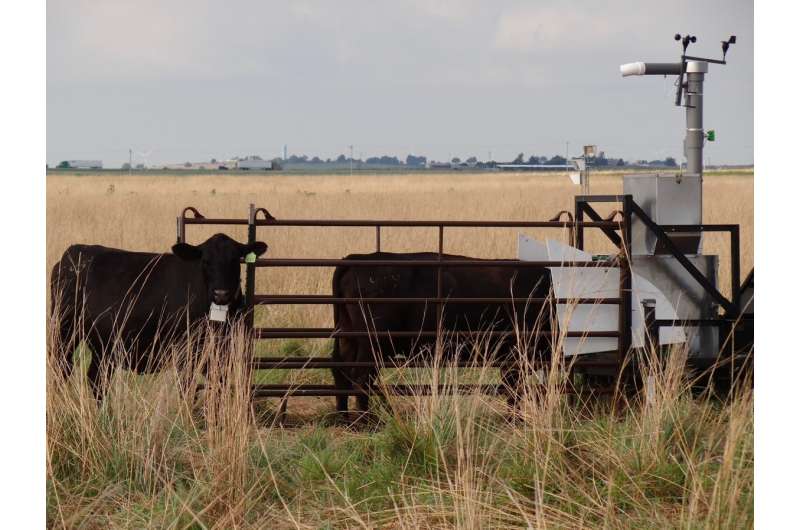Scientists breathalyze cows to measure methane emissions

Cattle burps are the No. 2 source of methane in the U.S., but it's tricky to measure exactly how much methane one cow produces in a day. That's why researchers at the USDA-ARS Conservation and Production Research Laboratory in Bushland, Texas set out to use a number of different methane assessment methods—including a "breathalyzer for cows"—to determine the methane emissions of free-range cattle on Oklahoma grasslands.
Their research, combined with data on how well the soil traps methane, can help create more accurate models of just how much greenhouse gas emissions Americans can chalk up to their fondness for cheese and hamburgers.
Methane is a potent greenhouse gas. Although it remains in the atmosphere for a shorter time than carbon dioxide, it has a warming potential 34 percent higher than that of carbon dioxide. According the Environmental Defense Fund, methane is responsible for around 25 percent of manmade global warming.
The USDA researchers were interested in measuring the amount of methane each cow was producing in a day. However, gas production is difficult to track.
"It's a real challenge because the cattle are basically mobile point sources of methane," said Richard Todd, a research soil scientist at USDA who presented the work last month at the 2018 AGU Fall Meeting in Washington, D.C. "They're moving around, they're grazing, the vegetation is changing, their bodies are changing as they go through lactation and pregnancy and so on. It's a really dynamic situation. What we wanted to do was employ a number of different methods to measure methane."
One of the methods, called GreenFeed, is basically a breathalyzer for cows. The device was designed by C-Lock Inc., a scientific company specializing in livestock measurement tools.
"Cattle are trained to put their head into an open hood (with food), and while they're there munching on the little treat the device is sampling their breath," Todd said. "Then we can calculate the methane emissions while they're inside."
Contrary to popular thought, 95 percent of cattle methane is released when the cows burp, not when it comes out the other end. But simply breathalyzing the cows was not enough to make an accurate assessment of how much method each cow was producing, so the researchers supplemented their work with other methods.
Two of the additional approaches predicted methane emissions using mathematical models of how much the cows ate and various other factors. One used lasers to track emissions as they rose from the herd, and factored them into a model with weather and location of individual cows. One measured methane concentrations upwind and downwind of the herd.
After collecting and analyzing all the data from the different methods, the researchers combined the data to get their answer. Each cow grazing the area of native Oklahoma prairie produces around a half-pound of methane per day. The numbers changed slightly with the seasons, probably due to changes in the cows' diets, according to the researchers.
The amount of methane a cow produces, the researchers found, is mostly a factor of how much it eats and what kinds of food it consumes. This was evident in the differences in methane production during different grassland seasons.
Interestingly, if a cow chows down on easily digestible food such as corn, it produces about a third as much methane as a cow that grazes on prairie grasses. This means that cows in high-density livestock operations such as feedlots or dairies actually produce less methane than grass-fed beef.
"That's definitely a happy accident," Todd said. "I do not think that they remotely considering methane emissions. Corn's cheap, it's easy, and it's quick to feed them in feedlots."
However, Todd cautions that in order to understand the whole cycle of methane, scientists must take into consideration other forces in the ecosystem. Grasslands such as the U.S. Great Plains, for example, are methane sinks. The bacteria in healthy soil can consume enough methane to compensate for at least some of the livestock emissions, a process that may not be as efficient in cows kept shoulder-to-shoulder in fenced-in farms, he said.
Charles Rice, a researcher at Kansas State University, is working on the soil side of the equation.
"(Todd) has measured the methane emitted by the cattle itself, so what we're doing then is then putting the pieces together," Rice said. "We know what cattle emissions are. So we measure what the soil was doing, and then we can do a budget and balance it out."
Provided by American Geophysical Union
This story is republished courtesy of AGU Blogs (http://blogs.agu.org), a community of Earth and space science blogs, hosted by the American Geophysical Union. Read the original story here.



















